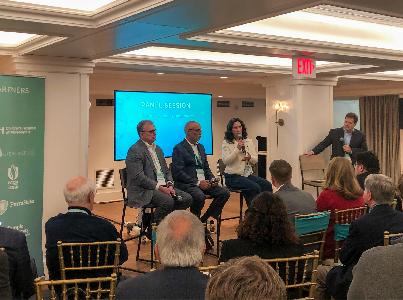Tom Boutell is a modest guy. Considering that one of his most notable achievements is so much a part of the background of the web, figuratively and literally, maybe that character trait makes sense.
Boutell is responsible for heading up the working group that designed the framework and specification for Portable Network Graphics, known more commonly as the PNG file format. It’s a format that you’re likely to find on any page on the web, seated beside and behind JPEGs and GIFs, more well-known image formats. “It would be hard to find a website that doesn’t have at least one PNG on it,” Boutell says. There was even a book written about the format, published by the industry leader O’Reilly, pictured above.
Boutell moved to Philadelphia in 2002 to be close to family, while working with his consultancy, Boutell.com, selling web analytics and image map editing software he had written. Eventually, the business fell behind the wave of web innovation as a solo act, and Boutell joined P’unk Ave, the South Philadelphia web development firm, where he cherishes the ability to “work with people of complimentary skills,” he says.
But back in 1993, Boutell was hooked into a community that was helping define the future of the World Wide Web. We caught up with him to hear the back-story, after the jump.
 What are you up to these days?
What are you up to these days?
I’m at P’unk Ave as the lead back-end engineer on the Apostrophe project. We’re friendly beta-testing a hosted version of Apostrophe, which will allow people to sign-up and build websites quickly and painlessly with same convenient editing tools we’ve been giving our clients.
What is the hosted version of Apostrophe all about? Any tricks up your sleeve?
Right now we get calls from small clients and we have to turn them away, so we’re trying to create a service that would work for them. One of the nice things is we built a CSS editor with versioning so you can do testing and roll-back in a way that’s better than other platforms.
Do you have a sense of what percent of the web uses PNG? Do you have a count of how many websites use it?
You have to look at it the other way: it would be hard to find a website that doesn’t have at least one PNG on it. If it’s a photo, it should be a JPEG. If it has line art, sharp edges, or text, it should be a PNG.
Set up the back story for us.
In 1993, I was working at Cold Spring Harbor Laboratory, where Watson and Crick worked. I was lucky enough to be in a job where we had good access to the Internet before the web was a thing. We really wanted to use it and share biology research information, but people at the time didn’t get the web, like why it was better than Gopher [an early document sharing system]. There was a need for a good document explaining how to use it. That’s where I got my start, editing my WWW FAQ. I edited that for many years. I also created GD Graphics Library, a graphics software library for PHP programmers to use if they wanted to generate graphics on the fly: scale an image, render it a different size, add a caption. Then, I moved from Long Island out west to work at RealPlayer [Boutell wrote Real Audio Player 1.0] and was telecommuting, by a 28.8k modem, to Cold Spring Harbor.
Where does PNG fit into this?
I was using GD Library to draw biology data on pictures of cells. At the time, it was ouputted to GIF because that was the file people used. But in 1994 into 1995 there was a controversy around GIF emerging. UNISYS had a patent on the compression, and eventually said, ‘hey, people are using it, if we enforce this patent, we’ll get a lot of money.’ There was panic on the Internet, and people were screaming about what to do to replace GIF.
What happened next?
People were writing competing proposals for a replacement. Most were very self-serving. I wrote a proposal saying ‘here are ideas, here is a structure, here’s where the algorithm should go, and I’d love to have feedback.’ A community coalesced around the proposal. Over a mailing list, we built the new specification that evolved into PNG.
So others were involved?
I headed the effort, but I didn’t write it myself. I acted as a benevolent dictator. It’s gratifying that it really worked out, but it took a decade before every web browser supported it. Surprisingly, Microsoft was one of the early adopters. One day, I got an email from them that said they liked PNG. I figured they’d turn it into an evil monster that would devour me in my sleep.
How do you explain or cherish the impact?
Everyone always wonders, ‘am I still doing good work, have I accomplished anything meaningful?” It’s nice once in a while to be reminded. If I click that right mouse button and hit ‘inspect element’ on a piece of line art, it’s probably going to be PNG. That really is a nice feeling.
My 12-year-old daughter thinks it’s pretty insane that her dad did that. For now. At some point, she’ll realize that I’m the reason that there’s so much power being used by computers, or something.
Join the conversation!
Find news, events, jobs and people who share your interests on Technical.ly's open community Slack

Philly daily roundup: Women's health startup wins pitch; $204M for internet access; 'GamingWalls' for sports venues

Philly daily roundup: East Market coworking; Temple's $2.5M engineering donation; WITS spring summit

Philly daily roundup: Jason Bannon leaves Ben Franklin; $26M for narcolepsy treatment; Philly Tech Calendar turns one

